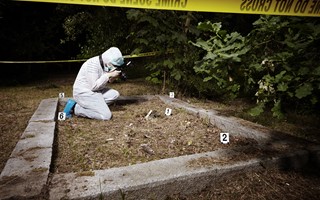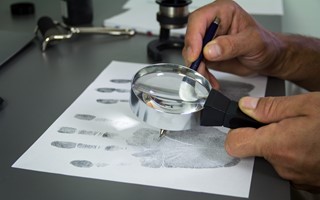News May 04, 2020 5m
The fragmentated approach to Forensic Science in the Criminal Justice System (CJS) is an issue that was raised as part of the inquiry into forensic science in criminal justice. It is mentioned in Dr Angela Gallop’s article “Forensics and Pandemics: The Prevention of Criminal Injustice” and has become part of the discussion of how Forensics is used in Criminal Law.
What is fragmentation in forensics?
Fragmentation occurs when different parts of the same case are worked on by multiple scientists at different laboratories. This can mean one exhibit is separated into several parts and analysed by different people who are in-turn unaware that there are other parts being analysed. In the worst cases this can mean there is no one scientist who has full sight on the whole examination and doesn’t ‘overview’ the results of the several parts either.
For example, an item of clothing may be examined by a police forensic scientist at their in-house forensic laboratory. This scientist finds some bloodstaining on the item of clothing, cuts out a bloodstain pattern and sends it for DNA profiling. The DNA profiling, the interpretation of the results and the comparison to your client’s DNA profile is carried out by a different forensic scientist at a privately owned forensic science provider (FSP). Some forces request that the results are sent back to the original police scientist in the form of a data table to be incorporated into their report. However each force has its own protocols, and ways of working alongside the FSPs, which further complicates and enhances the amount of fragmentation in the marketplace.
It is not always immediately obvious from the forensic report or statement that this work has been carried out by different people, and where the whole process hasn’t been overseen by one forensic scientist can lead to issues.
Why does fragmentation happen?
Largely fragmentation occurs due to limited police budgets. After the closure of the Forensic Science Service (FSS) in 2012 it was decided that is was more cost effective to do a large proportion of the forensic work in-house. However, it was deemed too expensive for the police forces to set up laboratories to do the DNA testing themselves. As the accreditation required to set up DNA Laboratories is very costly this continues to be done by the private FSP’s.
Police budgets are tightly controlled and often the person in charge of setting the forensic strategy for the case is not a forensic scientist and has limited forensic knowledge. Nevertheless, their role will be to determine which items may produce a probative result in the case, and how they can get to that point effectively and efficiently in terms of budget. In an attempt to save money whilst getting the desired outcome, the case is submitted for forensic examination in a staged approach. Often the primary concern of the person choosing the route to send the samples down is cost rather than what is best for the case in terms of forensic strategy.
What issues can result from this fragmented approach to examination of exhibits, and what does it mean for a case?
In the simplest of cases this means that you will likely have to contact both laboratories to gather the information required for a defence review to take place. At Forensic Access we can do this for you as we have scientists experienced in the marketplace and who understand the intricacies of the submission processes. Additionally, we have good working relationships with the laboratories in question and can request exactly what we need in order to do the work.
Once your case goes to court, if there is a dispute around the forensic evidence it is likely that both prosecution experts will be required to give evidence. This is because the police scientist is only able discuss the aspects of the work that they have undertaken and cannot comment on the interpretation of the DNA. The DNA forensic scientist will need to take the stand in order to discuss the intricacies of the DNA profile and their interpretation. With the introduction of newer more sensitive DNA profiling techniques, the DNA profiling results are increasingly complex and as such often require the expert to go into significant detail in the court. The combination of experts can be confusing for the jury and makes it harder for the prosecution barrister to put their questions to the experts in a manner that tells the story. To make matters worse it can be commonplace now for DNA questions to be posed to the police forensic scientist. Whilst this may seem to be acceptable, it can be a dangerous approach, as noted above they have not seen the DNA results themselves, so they are ill-placed to comment on the technical aspects of the profile, especially if specialist statistical analysis has been completed.
Scientists should be able to undertake a full and thorough review of all aspects of the work undertaken, and as such can often provide a clearer picture both for yourselves, your counsel and the jury.
If this is the situation for simple cases, what happens in a more complex case?
I think the best way to illustrate this is to use a case example that one of our expert forensic biologists, Clare Jarman explains in her webinar ‘DNA evidence in sexual assaults’.
This was a case where a handgun and magazine were found within a sock, that was within a yellow drawstring bag found in the vicinity of a robbery. All the items were examined at the police laboratory by different scientists at various stages within the investigation. This is a staged approach and is very common during forensic examinations where cost is a consideration.
The samples taken from each item for DNA were sent down different routes to the FSP. The swabs taken from the gun and magazine were sent down the major crime route at the FSP as you would expect and reported by two different DNA scientists. Samples from the sock and the bag were sent down the volume crime route, a high throughput line with no case assessment or strategy done by a scientist. All three samples generated matches against the national DNA database (NDNAD). However, the police force requested that the result from only one of the samples from the sock was confirmed by a 3rd DNA scientist in a match confirmation statement. The result from the sample on the bag was reported on an SFR1 despite the result and match having never been checked or confirmed by a scientist.
The police scientist who reported the results in relation to the firearm was not aware of the DNA results from the bag and the sock and so had not considered the possibility of secondary transfer of the clients DNA from the sock on to the firearm.
So this case was going to court with 4 different scientists having worked on it but without a single one of them having seen all the results and considered the implications each might have on the other and within the context of the case.
This is where our team got involved. The barrister in the case had worked with us on many occasions before and knew that we would be able to unravel the complexity of the case and produce a report that not only considered all the evidence but presented it in an easy to understand format.
We are currently working on a checklist for legal professionals in spotting and working with fragmentation in their cases, this will be announced through our newsletter and social media (Twitter @ForensicAccess). Subscribe to them to keep updated for new articles, webinars and the upcoming resources for Legal Professionals.
To find out more about our DNA services offered by Forensic Access fill-in our online contact form or Tel: 01235 774870 to speak with our team.


